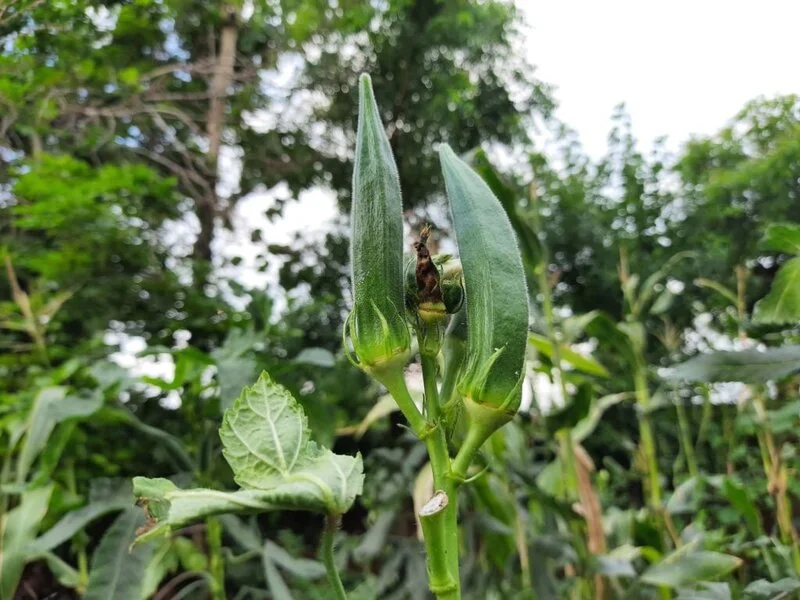Okra, a culinary mainstay in the South, has pods that are both colorful and seedy. Many green thumbs want to know the secret to growing this plant for its delicious and healthy flavor. The use of a trellis for okra is often questioned. To answer this, it is necessary to have some background knowledge on trellises and the okra plant.
- Name: Clemson Spineless Okra | Type: Heirloom
- Size at Maturity: 3″ Green Pods | Days to Maturity: 60 Days
- Light Requirement: Full Sun | Planting Time: Warm Season
- Planting Depth: 1/4″ | Plant Spacing: 12″ |Hardiness Zones: All
Understanding Okra
Okra, or Abelmoschus esculentus in its formal name, is a warm-season African vegetable. Okra is a tall plant that can reach heights of 4 to 6 feet in the garden; it is most recognizable for the long, pointed seed pods it produces. The plant can support itself thanks to its robust stems and upright growth style.
The blossoms of the okra plant are just as interesting as the pods. The enormous, stunning flowers range from yellow to white on the outside and have a vibrant red center, much like its close botanical relative, the hibiscus. When the blossoms die off, we can harvest the pods to use in cooking.
The harvest from your okra plants may be substantial. This plant thrives in warm, well-drained soil and consistent watering in full sun. But it’s still unclear whether or not a trellis is necessary for this tall vegetable.
The Role of a Trellis
A trellis is an upright structure used in gardening, often for climbing plants or plants that would benefit from some guidance as they grow. Imagine it as a shoulder for plants to rest on if they’re having trouble keeping their balance. Vining plants like cucumbers, peas, and even some flowers benefit from being supported by trellises.
A trellis not only helps plants thrive, but also makes better use of available garden space by encouraging their upward growth. Increased airflow around plants has the potential to reduce disease. Furthermore, trellises can facilitate harvesting because raised beds make fruits and vegetables more easily accessible.
Knowing what we do about okra and trellises now, we may investigate if okra plants need a trellis for support.
- SMALL SIZE – Length: 10.2″/26cm; Upside width: 6.1″(15.5cm); Underside width: 2.2″(5.5cm), perfect small trellis for potted plants. Dark green makes it invisible for beauty
- PREMIUM TRELLIS – These climbing plant trellis are made of high quality PP plastic, strong & practical trellis for climbing plants, suitable for indoor or outdoor use
- STACKABLE DESIGN – You can superimpose the mini garden trellis as your desired: Connect them side by side or upward to make the width and the height you need to shape your plant more beautiful and be healthier
- PERFECT SUPPORT – Our climbing trellis work well to help your climbing plants standing up and vine plants off the ground. Perfect for house plants, sugar snap peas, pot flowers support, green beans and small chili pepper plants. Great little planter trellis – very handy for propping up wayward stems and droopy branches on smallish plants
- EASY TO USE – Super easy to assemble and use, and easy to adjust as the plants grow. Just stick these plastic mini garden plant support trellis into the soil or fix it on the wall or support stakes
Does Okra Need a Trellis?
Here’s the simple answer: okra typically does not require a trellis. Okra, in contrast to vining plants, which tend to climb, grows erect on strong stems and can hold its own without any help. Each okra plant displays equal erectness, its broad leaves proudly swinging in the breeze. As a result, a trellis isn’t always required.
In rare cases, though, okra might benefit from being supported by a trellis or other structure. A little extra support may be needed if the plant is situated in a windy area. In a similar vein, an okra plant that has become overloaded with pods may benefit from a stake or a modest trellis. However, most gardeners won’t need a trellis for their okra plants to grow and thrive.
Tips for Growing Okra Successfully Without a Trellis
More important than trellises for good okra cultivation are warmth, water, and attention. Full sunlight and temperatures over 60 degrees Fahrenheit are essential for successful okra cultivation.
If you are in a cooler place, start your okra seeds indoors; if you are in a warmer area, put them outside. Leave enough room for each plant to flourish; a distance of 1 to 2 feet is recommended.
Be sure to keep your okra moist, but avoid drowning it. It’s ideal if the soil is damp but not soggy. Overwatering is often blamed for leaves turning yellow. The okra pods should be picked when they are about three to four inches in length. They lose texture and flavor if they get too big.
Conclusion
Is a trellis necessary for okra? The answer is typically negative. This self-reliant plant may provide height and beauty to your landscape without any additional assistance. The success of your okra crop depends on your familiarity with the plant’s requirements and your ability to meet those needs. If you give your okra plant the TLC it needs, you’ll be rewarded with a crop of fresh okra pods. Enjoy your gardening!






